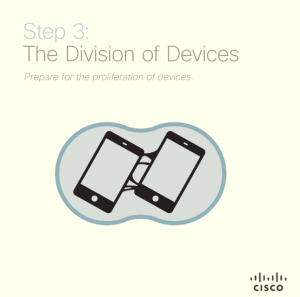































This is the third post in a blog series featuring Vine-format videos focusing on the"Six Essential Steps for Unleashing the Power of Enterprise Mobility".Be sure to read the first two blogs and watch the videos -First Step to Enterprise Mobility: Build the Mobile Structureand Second Step to Enterprise Mobility: Go Virtual.
In this blog series, we've discussed two important steps enterprises can take unleash the power of enterprise mobility. We've covered how building a mobile structure can arm enterprises with the appropriate architecture to increase efficiency and revenue. In addition, we highlighted how enterprises can go virtual by implementing desktop virtualization.
Our third step -preparing for the division of devices -relies on both structure and a mobile workforce. How can enterprises enable and support the proliferation of employee-owned devices without burying their IT department and putting corporate data at risk? Here's a quick checklist to help make it happen:
 1.Use a unified network infrastructure that facilitates secure, virtual workspace delivery across wired, wireless, VPN, and cellular networks.
1.Use a unified network infrastructure that facilitates secure, virtual workspace delivery across wired, wireless, VPN, and cellular networks.
As wireless access becomes more pervasive, performance and reliability expectations are the same as what is expected from a wired network. Features such as reliable connectivity, application response times and voice, video and real-time collaboration solutions all depend on a seamless delivery for both wired and wireless devices. This fundamental shift demands that IT monitor and have a unified solution in place (i.e. a single physical infrastructure) for both corporate wireless LAN (WLAN) and wired LAN. This converged infrastructure will enable the right quality of experience for users, independent of their devices.
A unified network infrastructure can also make sure that IT is able to identify each device connecting to the network and authenticate the person using it.
2. Create a comprehensive, unified end-to-end architecture to support users, devices, and locations.
A unified architectural approach provides an organizing principle-or framework-for everything from switches and routers to video, servers, wireless access points, security, and business applications. It gives you a solid foundation on which to build and evolve BYOD plans and policies. An architectural approach also makes it possible to create scalable policies that can accommodate mass mobility.
Without an architectural approach, BYOD can actually hinder productivity instead of helping it due to poor performance and employees opting not to use company-provided productivity tools because they do not perform well on employees' personal devices.
Today we discussed a short checklist for preparing organizations for the division of devices. For more information about virtualization and additional steps to consider, check out this Cisco whitepaper, "Six Essential Steps for Unleashing the Power of Enterprise Mobility." Stay tuned for my next post that will discuss the fourth step enterprises can take to unleash the power of mobility.
 Hot Tags :
Mobility
Mobile
network
Wi-Fi
BYOD
wireless
bring your own device
mobile device
enterprise mobility
Hot Tags :
Mobility
Mobile
network
Wi-Fi
BYOD
wireless
bring your own device
mobile device
enterprise mobility